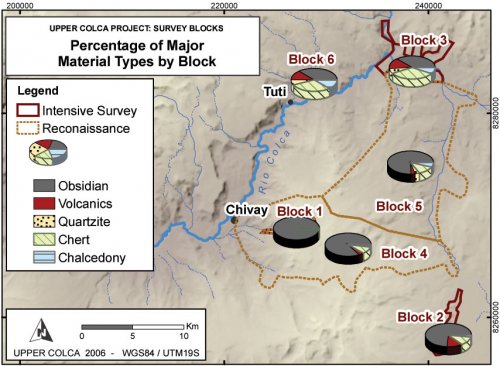Lithic raw material in the vicinity of the Chivay source
Variability in material type throughout the survey area make clear the basic structure of lithic procurement in the area of the Chivay source.
Figure 6-1. Artifactual lithic material types in theUpper Colca Project study region.
|
Obsidian |
Volcanics |
Chalcedony |
Chert |
Quartzite |
Total No. |
||||||
|
Block |
No. |
% |
No. |
% |
No. |
% |
No. |
% |
No. |
% |
|
|
1 |
381 |
97.9 |
2 |
0.5 |
0.0 |
6 |
1.5 |
0.0 |
389 |
||
|
2 |
369 |
72.9 |
71 |
14.0 |
11 |
2.2 |
50 |
9.9 |
5 |
1.0 |
506 |
|
3 |
149 |
39.3 |
45 |
11.9 |
26 |
6.9 |
139 |
36.7 |
20 |
5.3 |
379 |
|
4 |
190 |
85.2 |
9 |
4.0 |
6 |
2.7 |
18 |
8.1 |
0.0 |
223 |
|
|
5 |
235 |
75.6 |
13 |
4.2 |
15 |
4.8 |
36 |
11.6 |
12 |
3.9 |
311 |
|
6 |
22 |
39.3 |
6 |
10.7 |
6 |
10.7 |
19 |
33.9 |
3 |
5.4 |
56. |
|
Total |
1346 |
72.2 |
146 |
7.8 |
64 |
3.4 |
268 |
14.4 |
40 |
2.1 |
1864 |
Table 6-5. Counts of artifactual lithics material types throughout the study region.
The availability of raw material throughout the region is inferred from the variability by material type from artifact collections throughout the study region. In the volcanic region of Block 1 and Block 4, obsidian is the principal locally available material. Block 4 extends into lower elevations regions on the east and west, and chert may be available in streambeds in those regions. Block 2 has larger quantities of fine-grained volcanic stone, mostly andesites, and these were heavily used in Late Archaic. Chert is relatively abundant in Block 2 as well, which suggests that there is a chert source not far from that block. Blocks 3 and 6 show the abundance of chert and chalcedony available in the upper Colca valley area, and multicolor chert cobbles were observed in several stream beds in Block 3. Quartzite is also used in Block 3, a material that was observed eroding out of the ridgetops. Block 5, as with Block 4, appears to contain a variety of raw material types within its boundaries.
Nodules of obsidian had their geological origin entirely in the Maymeja area of Block 1 and the adjacent areas of Block 4. The only other exposure of Chivay type obsidian encountered in the course of this research was the Pulpera / Condorquiña flow - a small exposure of Ob2 obsidian nodules, all measuring less than 5cm, at the toe of a long Barroso lava flow near Pulpera in Block 5. The Condorquiña flow probably saw very little use in prehistory due to small size and poor obsidian quality.
Based on the assumption that the survey was comprehensive and that there are no other exposures of Chivay type obsidian in the Ancachita - Hornillo area, it is proposed that culturally-modified of obsidian was transported radially from the source area in Block 1 and Block 4.
